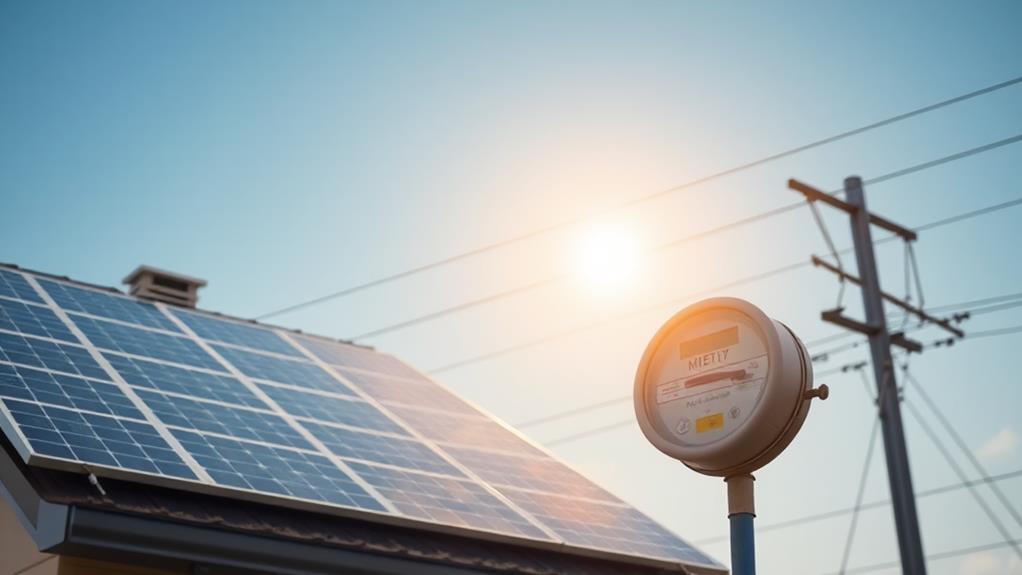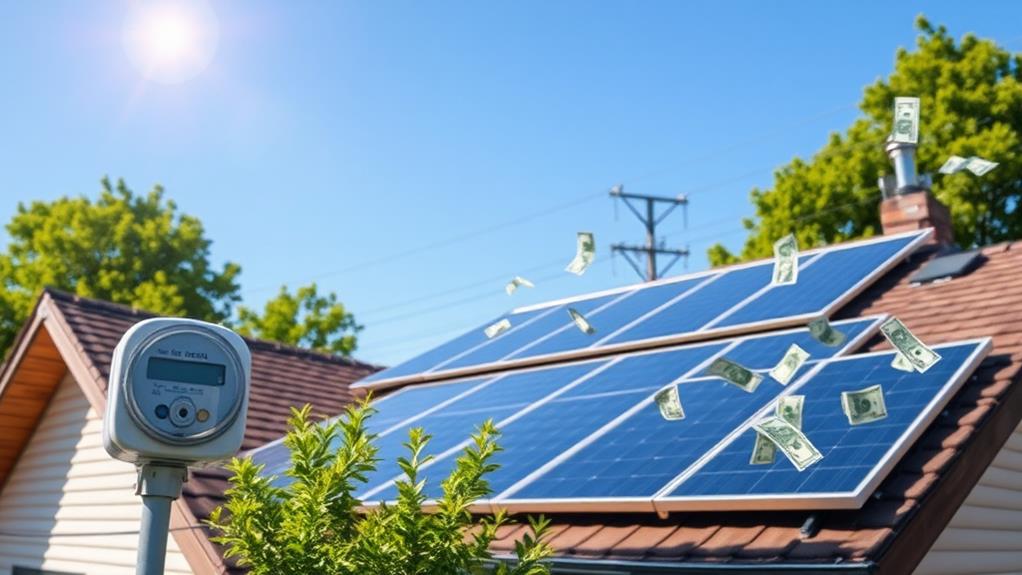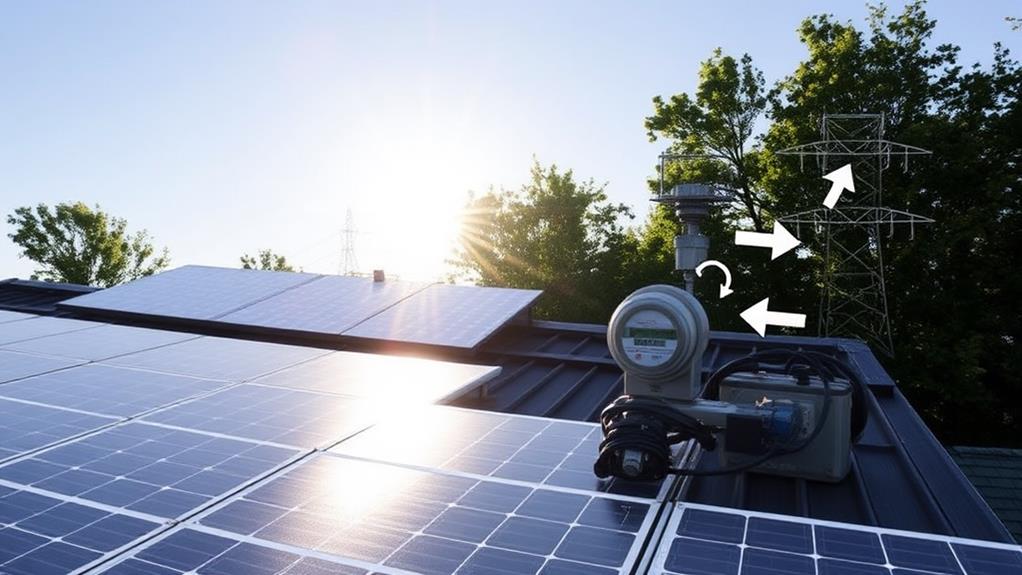Net metering is a billing mechanism that lets you send excess solar energy back to the grid for credit. When your panels produce more than you use, your meter runs backward, and you're only billed for your "net" energy consumption. This system effectively turns the grid into a virtual battery, storing your surplus for later use. You'll benefit from reduced electricity bills, protection against rising energy costs, and a quicker return on your solar investment. However, net metering policies vary by state and utility, affecting the economics of your solar system. Understanding these policies is crucial for maximizing your solar savings potential.
What Is Net Metering?

How does net metering work? It's a billing mechanism that allows solar panel owners to send excess electricity back to the grid and receive credit for it. When your solar panels generate more power than you're using, the excess is fed into the utility grid. Your electric meter runs backward, tracking the energy you've contributed. Later, when you need more electricity than your panels are producing, you can draw from the grid using these credits.
Net metering essentially turns the grid into a virtual battery for your solar energy system. You're only billed for your "net" energy use, which is the difference between the energy you've consumed and the energy you've produced. This system can significantly reduce your electricity bills and increase the value of your solar investment.
The specifics of net metering policies vary by state and utility company. Some offer full retail rate credits, while others use avoided cost rates. It's crucial to understand your local net metering rules when considering solar installation, as they can greatly impact your system's economics and payback period.
How Net Metering Works
The inner workings of net metering resemble a carefully choreographed dance between your solar panels, home, and the electrical grid. When your panels produce more electricity than you're using, the excess flows into the grid. Your meter spins backward, crediting you for this surplus energy. Later, when you need more power than your panels generate, you'll draw from the grid, and your meter spins forward.
At the end of your billing cycle, you're only charged for the "net" amount of electricity used. If you've generated more than you've consumed, you'll typically receive a credit on your next bill. This credit can offset future electricity costs, especially during less sunny periods.
Net metering allows you to maximize your solar investment by ensuring no generated electricity goes to waste. It effectively turns the grid into a virtual battery, storing your excess production for later use. The system's beauty lies in its simplicity and efficiency, requiring no additional equipment beyond a bi-directional meter. By participating in net metering, you're not just saving money, but also contributing to a more sustainable energy ecosystem.
Benefits for Solar Panel Owners

Solar panel owners reap numerous benefits from net metering programs. You'll see a significant reduction in your electricity bills, as you're credited for the excess energy you produce. This credit offsets the cost of power you draw from the grid when your panels aren't generating enough electricity, such as at night or on cloudy days.
You're also protected against rising energy costs. As utility rates increase, the value of your solar-generated electricity grows, maximizing your long-term savings. Net metering enhances your return on investment, shortening the payback period for your solar installation.
Additionally, you're contributing to a cleaner environment by reducing your reliance on fossil fuels. This can increase your property value, as eco-friendly homes are increasingly desirable to buyers. Some states offer additional incentives, like Solar Renewable Energy Credits (SRECs), which you can sell for extra income.
Net metering simplifies your solar experience by eliminating the need for expensive battery storage systems. It allows you to use the grid as a virtual battery, storing your excess energy credits for later use. This arrangement makes solar power more accessible and cost-effective for homeowners like you.
Grid Implications and Challenges
Despite its benefits for solar panel owners, net metering presents significant challenges for utility companies and the broader power grid. As more customers adopt solar panels and feed excess energy back into the grid, utilities face reduced revenue and increased grid maintenance costs. They're still responsible for maintaining infrastructure and providing reliable power, even as their customer base shrinks.
This shift can lead to a "utility death spiral," where remaining customers face higher rates to cover fixed costs, potentially driving more to adopt solar. This creates concerns about grid stability and the equitable distribution of costs among all users.
Net metering also complicates grid management. The intermittent nature of solar power can cause voltage fluctuations and require utilities to invest in advanced grid technologies. Additionally, it may necessitate changes in power plant operations to accommodate varying levels of solar input.
Lastly, there's the challenge of accurately valuing solar energy. Utilities argue that net metering rates often don't reflect the true cost of grid services provided to solar customers, leading to debates about fair compensation and potential cross-subsidization between solar and non-solar customers.
Policy Landscape Across Different States

While net metering policies exist nationwide, you'll find significant variations across different states. Some states offer full retail rate compensation for excess solar energy, while others provide lower rates or have implemented alternative programs. You'll see that states like California, New Jersey, and Massachusetts have robust net metering policies, encouraging solar adoption. In contrast, states such as Alabama and Tennessee have less favorable or no net metering laws.
You'll notice that many states have caps on the total capacity of net-metered systems or individual system sizes. These limits can impact the scalability of solar installations. Some states have also introduced time-of-use rates, which affect the value of solar energy based on when it's produced. You'll find that a few states have moved towards "net billing" or "value of solar" tariffs, which separate the compensation for excess energy from retail electricity rates.
It's important to understand that policies are continually evolving. Some states are phasing out net metering in favor of alternative compensation models, while others are strengthening their existing programs. You should stay informed about your state's specific policies and potential changes to make informed decisions about solar investments.
Economic Impact on Utilities
Net metering's popularity among solar adopters has sparked debate about its economic impact on utilities. As more customers generate their own electricity, utilities face reduced revenue from energy sales. This can lead to what's known as the "utility death spiral," where declining sales force utilities to raise rates, potentially driving more customers towards solar adoption.
Utilities argue net metering shifts costs to non-solar customers, as they must maintain the grid infrastructure without the full financial contribution from solar users. This concern has led some states to implement fixed charges or reduce compensation rates for excess solar energy.
However, it's important to note that solar adoption can also benefit utilities. It can reduce the need for expensive peak power plants and transmission upgrades. Some studies suggest that the value of solar to the grid may outweigh the costs to utilities.
As the industry evolves, you'll see utilities adapting their business models. Some are investing in large-scale solar projects or offering their own rooftop solar programs to maintain relevance in the changing energy landscape.
Net Metering vs. Feed-in Tariffs

As we consider alternatives to traditional net metering, it's important to compare it with another popular solar incentive: feed-in tariffs. Both mechanisms aim to promote solar adoption, but they operate differently.
Net metering allows you to offset your electricity bill with excess solar energy you produce. You're essentially using the grid as a battery, drawing power when needed and feeding it back when you generate more than you use. The utility typically credits you at the retail rate for this excess energy.
Feed-in tariffs, on the other hand, offer you a fixed price for all the solar energy you generate, regardless of your consumption. This price is often higher than the retail rate and guaranteed for a set period, providing long-term financial stability.
While net metering can lead to lower utility bills, feed-in tariffs may offer higher overall returns. However, feed-in tariffs require more complex billing systems and can be more expensive for utilities to implement. They're also subject to policy changes, which can affect long-term profitability. Your choice between these options will depend on your energy consumption patterns, local policies, and financial goals.
Future of Net Metering
Looking ahead, the future of net metering remains uncertain and subject to ongoing debate. You'll find that many states are reevaluating their net metering policies as solar adoption increases. Some utilities argue that net metering shifts costs to non-solar customers, while solar advocates maintain it's crucial for industry growth.
You may see a trend towards "net billing" or "value of solar" tariffs, where excess energy is credited at a lower rate than retail. This approach aims to balance utility concerns with continued solar incentives. Time-of-use rates could also become more prevalent, encouraging you to align your energy production and consumption with grid needs.
As battery storage becomes more affordable, you might find net metering policies evolving to incorporate energy storage solutions. This could lead to more grid-friendly solar-plus-storage systems, benefiting both utilities and consumers.
You should expect ongoing policy discussions and potential compromises between utilities, regulators, and solar advocates. The future of net metering will likely involve a more nuanced approach, considering factors like grid impact, time of generation, and overall system value.
Environmental Benefits and Considerations

While the economics of net metering continue to evolve, it's important to consider the environmental impact of solar energy adoption. Solar power significantly reduces greenhouse gas emissions compared to fossil fuels, helping combat climate change. When you install solar panels, you're decreasing reliance on coal and natural gas, which contribute to air pollution and water contamination.
Solar energy also conserves water resources, as it requires minimal water for operation compared to traditional power plants. This is particularly crucial in water-stressed regions. Additionally, solar panels have a long lifespan and are largely recyclable, reducing waste in the long term.
However, there are some environmental considerations to keep in mind. The manufacturing process of solar panels involves energy-intensive processes and some toxic materials. You'll need to ensure proper disposal or recycling of panels at the end of their life cycle. Land use can also be a concern for large-scale solar installations, potentially impacting local ecosystems. Nonetheless, technological advancements are continually improving the efficiency and environmental footprint of solar energy, making it an increasingly sustainable choice for power generation.
Calculating Your Net Metering Savings
Calculating your net metering savings can seem like a daunting task, but it's essential for understanding the full value of your solar investment. To begin, gather your electricity bills from the past year to determine your average monthly usage and costs.
Next, estimate your solar system's production using online calculators or consult with a solar installer. Compare your estimated solar production to your monthly usage. If you produce more than you consume, you'll receive credits for excess energy. Calculate the value of these credits based on your utility's net metering policy. Some utilities offer full retail rate credits, while others use avoided cost rates.
Factor in any time-of-use rates or peak demand charges that may affect your savings. Don't forget to consider seasonal variations in solar production and energy consumption. You'll also need to account for any fixed charges or minimum bills that remain regardless of your solar production.
Conclusion
You've delved into the world of net metering, thinking you'd master solar economics. Ironically, the more you learn, the more complex it becomes. Just when you've grasped the benefits, you're hit with grid challenges. You celebrate state policies, only to find they're constantly changing. You're left pondering the future, calculating savings, and weighing environmental impacts. Who knew going green could leave you feeling so in the dark?

